Frankfurt's botanical garden
KfW Stiftung has joined forces with Frankfurt’s Botanical Garden to promote the conservation of endangered wild plants in the region of Hesse.
Publikationen
In this project, 15 seed plants such as early sand grass (Mibora minima) and blue iris (Iris spuria) are planted on the grounds of the Botanical Garden. With the support of the competent authorities and nature conservation groups, they will later be reintroduced to the wild by being transplanted into their natural environment.
The aim is to reduce the risk of extinction for these plants that are currently included on the Red List of endangered species. The regional government of Hesse has a particular responsibility for their conservation given their endangered status in Germany. The project is part of the Global Strategy for Plant Conservation (GSPC), a programme of the Convention on Biological Diversity. As a signatory of this international treaty, Germany has accepted its share of the responsibility for plant conservation.
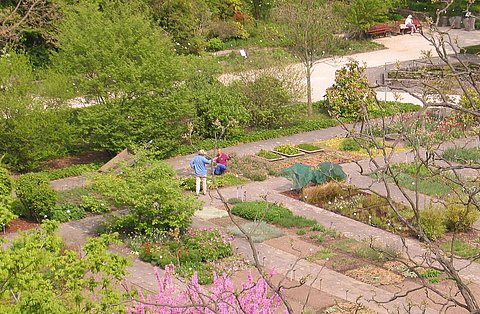
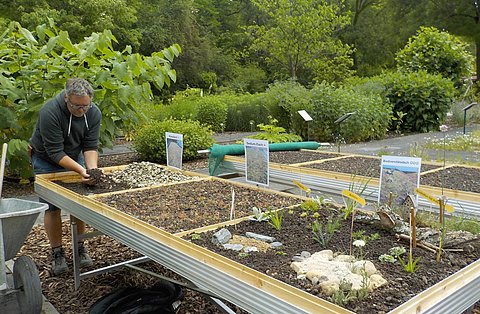
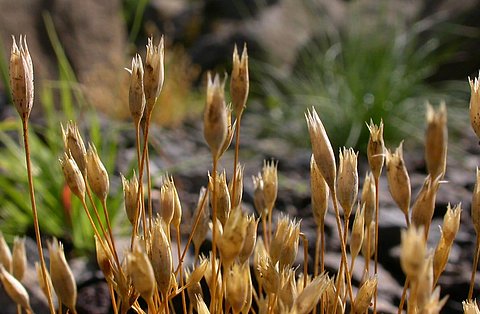
Living roofs – species-rich and diverse
Green roofs provide a habitat for numerous animal and plant species and create ecologically valuable biotopes in urban areas. The potential for nature and species protection has not yet been exhausted. Many of the currently existing green roofs are not yet created to promote biodiversity. Instead, they are planted with species-poor and cultivated varieties. This leads to a low ecological value.
The aim of the project is to make better use of roof areas in the Rhine-Main region for the benefit of local biodiversity between 2019 and 2024. The Rhine-Main area with the city of Frankfurt a. M. and surrounding communities already has numerous green roofs. The region is an important growth region in which all potentials for the promotion and preservation of biodiversity should be exploited.
The urban biodiversity on roofs in this region is to be increased through model upgrading measures, the search for suitable wild plants and the testing of local wild plants. Within the framework of the compensation scheme, it is possible to use roof areas that are rich in species and varied in design to compensate for development measures and thus contribute to reducing urban heating in summer, reducing noise, improving air quality and also retaining precipitation water on the area.
To test ecological enrichment under controlled conditions, the botanical garden built experimental plants that illustrate the aesthetic and ecological advantages of high-quality green roofs. They can be visited in the Botanical Garden Frankfurt. The project is also developing outside of the botanical garden. Together with more than 20 cooperation partners, the first roofs have already been analysed for their suitability and some have been upgraded with new planting. These roofs are additionally used as a research station to test different variants of ecological enhancement - different seed mixtures, drought-resistant perennials, bulb plants, enriching structures and maintenance practices.
In addition, the topic is made accessible to a broad public, public authority employees, planners and tradespeople in order to motivate owners of roof areas to create or upgrade them in a natural way.
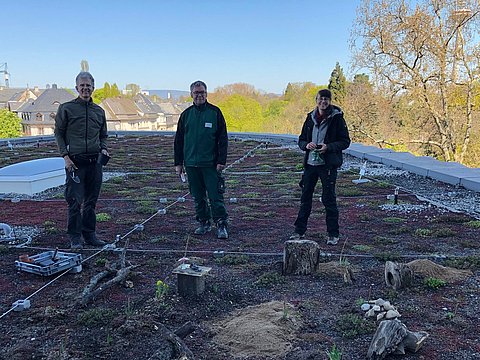
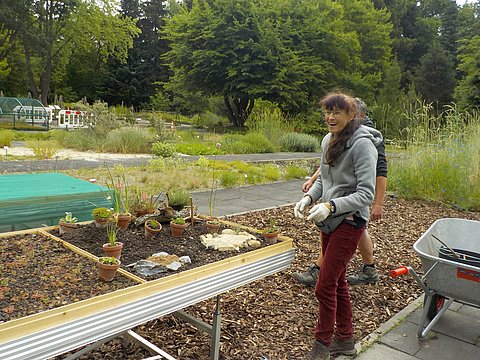
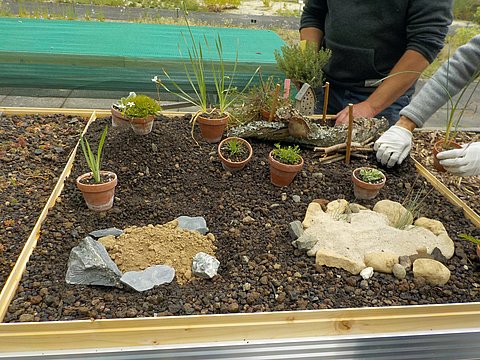
Plants – conservation project
The project kicks off with the arrival of spring. From the beginning of their annual growing cycle to autumn, plant experts collect seeds of the following plants:
Allium strictum, Festuca duvalii, Fumana procumbens, Jurinea cyanoides, Mibora minima, Moenchia erecta, Nigella arvensis, Poa badensis, Scleranthus verticillatus, Iris spuria, Sedum villosum, Spergula pentandra, Ventenata dubia, Veronica acinifolia, Vicia orobus
The project starts off with early sand grass (Mibora minima), reputed to be the smallest grass in the world. Its flowering season lasts from February to April. Growing on sandy soil, it is particularly common in southern Hesse.
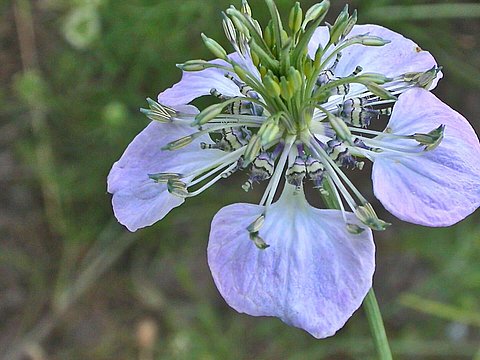
Reintroduction of early sand grass
Reintroduction activities began on 5 February 2016. The species early sand grass (Mibora minima) was planted in Rodenbach, not far from the town of Hanau. The project was supported by the German Association for Landcare (Landschaftspflegeverband – LPV) and the regional nature conservation authority (Untere Naturschutzbehörde) in the region of Main-Kinzig-Kreis. The scientific consultant was Dr. Karl Peter Buttler, who had collected the seeds the last time the grass grew in large quantities in the Hesse region. Only ten years ago, early sand grass could still be found in the Rodenbach area, but it disappeared as a result of a change in land use.
Early sand grass is one of the rare species that enjoy special protection by the regional government of Hesse. Even though rare and occurring only at the fringes of its distribution range, the remaining plants in this area are significant when compared to the amount of early sand grass in the world. The reintroduction on this and on other occasions in the future will reduce the risk of extinction for this species. Early sand grass will be grown on the grounds of Frankfurt’s Botanical Garden as a maintenance culture and can be inspected by the interested public. It can also be examined for scientific purposes, such as genetic research, which effectively contributes to its long-term conservation.
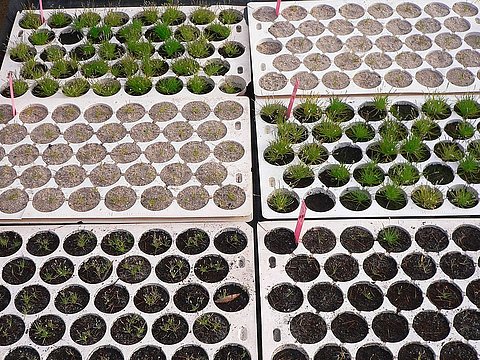
Rescuing Veronica acinifolia
In cooperation with Botanical Garden Frankfurt, KfW Stiftung is committed to the preservation of endangered endemic perennials in Hessia.
A small but important step for biodiversity: The Veronica acinifolia was re-settled for good.
The last of the wild endemic species was found in Pohlheim-Hausen, south-east of Gießen. In spring 2015, an expert commissioned by the Botanical Garden had discovered a single plant and managed to collect ten seeds. The conditions of the location had turned unfavourably; supporting measures were too late and in vain. By now, the population of Veronica acinifolia is extinct.
The few seeds that were collected, were reproduced in the Botanical Garden. In spring of 2017, a few dozen grown plants were ready to be transplanted. Their re-settlement in a new spot of a local conservation area was successful.
The preservation of the species was very demanding: searching for a new, appropriate location for the sprouts, monitoring the plants almost daily, cooperating with landscaping associations, documenting the progress in detail.
KfW Stiftung is supporting the project of the Botanical Garden for the conservation of 14 further endangered seed-bearing plants. The successful resettlement of Veronica acinifolia sets an example for the conservation of endangered species even in critical situations when common measures of preservation have failed.
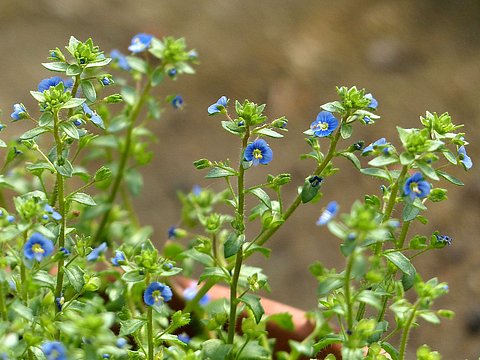
Publications
Programme Management
Pia Puljanic
Photo credits:
01. Image: Source: Botanischer Garten Frankfurt, Author / Photographer: Andreas König
02. Image: Source: Botanischer Garten Frankfurt, Author / Photographer: Andreas König
03. Image: Source: Botanischer Garten Frankfurt am Main, Author / Photographer: Elke Brude
04. Image: Source: KfW Stiftung, Author / Photographer: Pia Puljanic
05. Image: Source: Botanischer Garten Frankfurt, Author / Photographer: Andreas König
06. Image: Source: Botanischer Garten Frankfurt, Author / Photographer: Andreas König
07. Image: Source: Botanischer Garten Frankfurt am Main, Author / Photographer: Elke Brude
08. Image: Source: Botanischer Garten Frankfurt am Main, Author / Photographer: Uwe Barth
09. Image: Source: Botanischer Garten Frankfurt, Author / Photographer: Uwe Barth